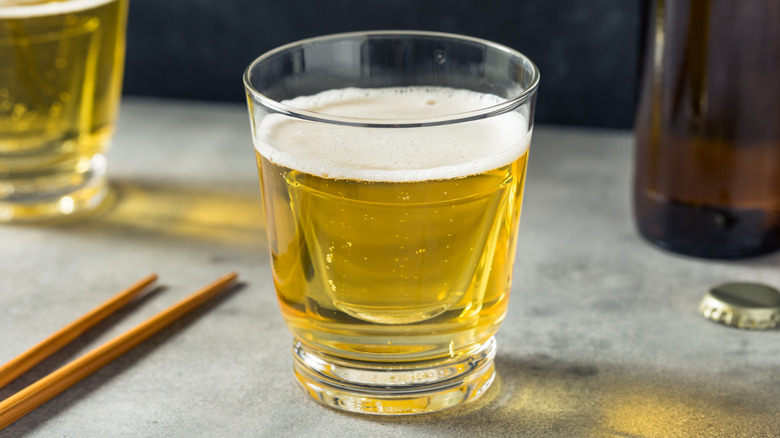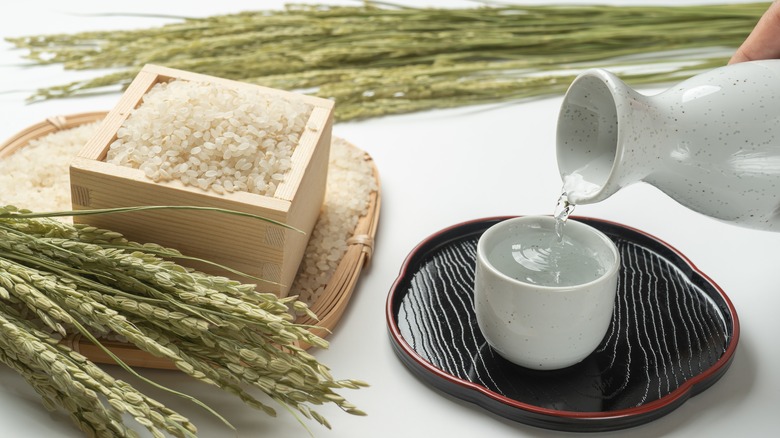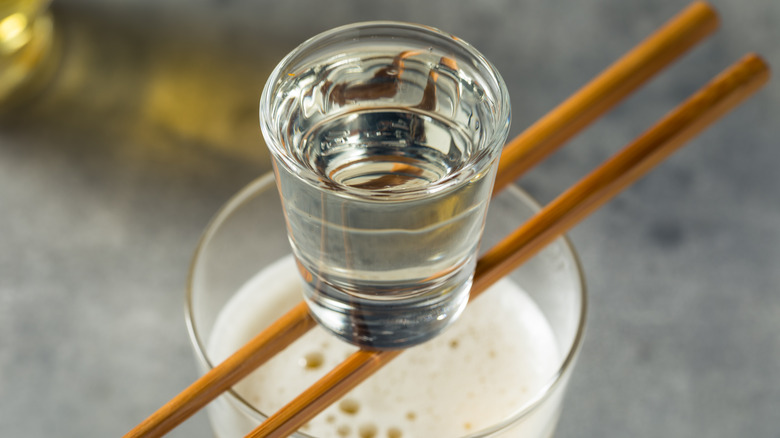The Best Beer For Expert-Approved Sake Bombs
The sake bomb is pretty much just a boilermaker, only with Japanese rice wine dropped into the beer instead of rotgut whiskey. The main difference between the two is that the former has long been considered a blue-collar drink, while the latter is the provenance of college kids, wine moms, and anyone else with the funds to get sloshed at a sushi bar. (In the U.S., that is – you aren't likely to find sake bombs in Japan.) If you'd like to try making this beer cocktail at home, you might be wondering what beer to use. That's a good question, so Mashed referred it to an expert: Mandy Naglich, a certified taster (yes, that's a thing) who wrote a book called "How to Taste: A Guide to Discovering Flavor and Savoring Life."
Naglich, who also runs a popular drinks Instagram in addition to her other beverage journalist activities, advocates for Japanese lagers such as Asahi Super Dry, Kirin, or Sapporo. Since they are made with rice, she feels they complement the rice in the sake and provide a neutral base. She tells us they "make for easy drinking sake bombs." She also notes that if you don't want to pay premium import prices, a domestic light lager will work. Some beers are best to steer clear of, though. She cautions: "Big hoppy flavors of an IPA or the roasty notes in a stout will get in the way of the intention of a sake bomb."
Sake should be cheap and cold
Okay, so the sake bomb isn't about showcasing fancy, flavorful beer. Is the sake, then, the centerpiece? Not exactly — as Mandy Naglich tells us, "Sake bombs are really more about the fun experience of drinking them together than they are about savoring sake or beer flavor." The good news, she goes on to say, is that "the best sake for a sake bomb will be something inexpensive."
As for the kind of sake, Naglich says that futsu-shu (table sakes) will be fine as their less-refined nature will be disguised by the beer bath. If you want a double-duty sake that can be used for drinking as well as bombing, she suggests ginjo or honjozo sakes but says to avoid junmai sakes. Not because these are bad, by any means, In fact, quite the opposite is true since these types of sakes are additive-free and thus tend to be pricey. Naglich, however, feels that "Using expensive sake in a sake bomb won't do much to change the flavor of the drink but will be a waste of both your money and the sake maker's creation."
One other thing you need to watch out for is the sake temperature. Sake used in sake bombs should be cold since hot sake will make the beer warm. "This isn't a great temperature to enjoy beer at," Naglich points out, explaining: "You'll end up tasting more harsh alcohols from both the sake and the beer."
As does the way in which you drink the sake bomb
Depending on who you go drinking with, your crowd may insist on observing certain sake bomb rituals such as pounding the table and counting in Japanese, but none of this is necessary when drinking sake bombs at home. Nor does the type of glass matter, according to Mandy Naglich. In her opinion, "The glass is more about ease of drinking than enhancing flavor." So she suggests a standard pint glass-shot glass combo. If your home bar only has narrow-mouthed beer glasses, though, you should skip the shot glass as it could wind up bonking you in the nose as you drink. Instead, simply pour the sake into the beer.
The speed at which you drink the sake bomb, or any beer, for that matter, does make a difference, since if you nurse it for an hour or so, the beer may grow warm and flat. "At cold temperatures," Naglich tells us, "the beer is still pleasant and fizzy, even though the sake has taken the fizz down a little." Once the beer gets warm and flat, it may take on what she calls "a sort of flabby, heavy flavor" while the alcohol flavor in both beer and sake becomes more pronounced. Even though sake bombs are best while the beer's still cold and bubbly, this doesn't mean you need to slam the drink. As Naglich notes, "You should never feel the need to force yourself to drink quickly."


